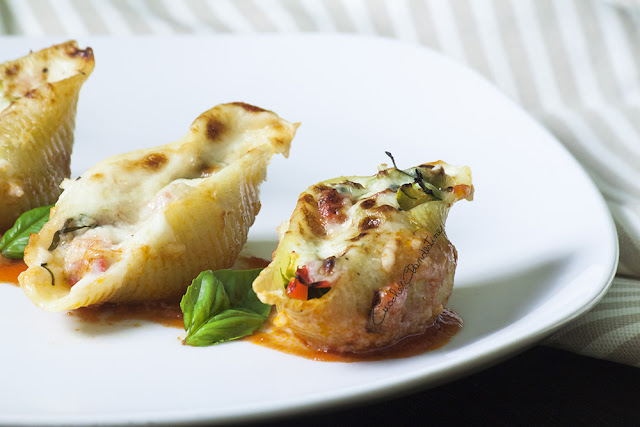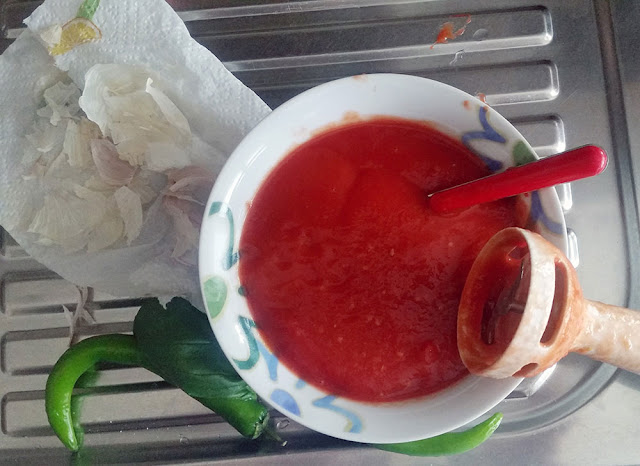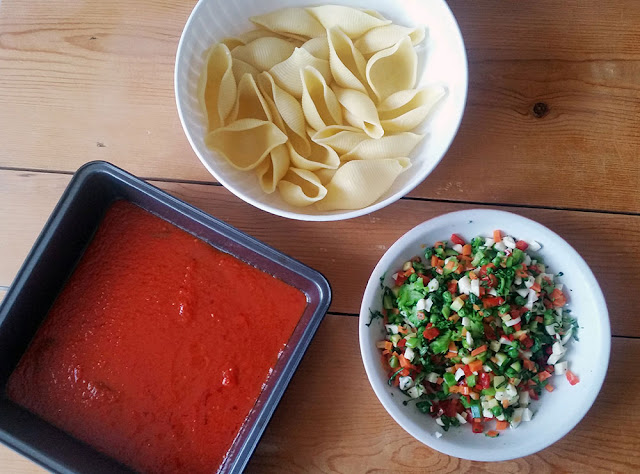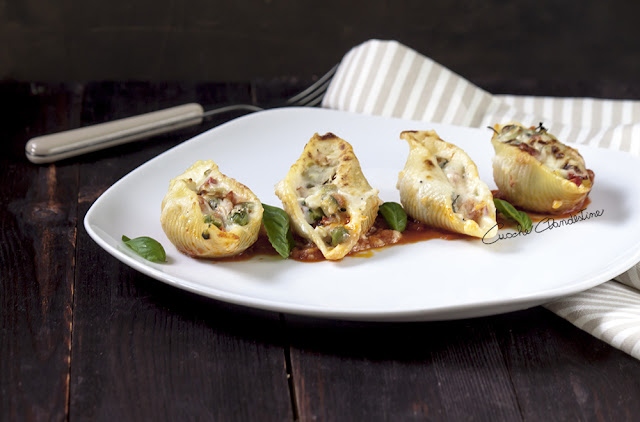English. Meanwhile dice the vegetables and the mozzarella. Chop the basil (about a couple of tablespoons). Bring to a boil two litres of water and blanch the vegetables (except the basil). To blanch means “soften by boiling”, so boil for just three minutes the diced carrot, pick up with a skimmer, and set aside. Make the same with the broccoli, the peas, the zucchini and the bell pepper.
Español. Mientras tanto, cortar todas las verduras y la mozzarella en pedazos. Picar la albahaca (aproximadamente dos cucharadas). Hervir dos litros de agua y blanquear las verduras. El blanqueamiento significa escaldar rápidamente, hervir las zanahorias durante tres minutos y sacarlas del agua con una espumadera y luego dejar de lado. Hacer lo mismo con el brócoli, los guisantes, el calabacín y la pimienta. Tres minutos por cada vegetal excepto albahaca.
English. Add 14 grams of seasalt to the boiling water in which you blanched the vegetables and cook the pasta al dente: they do not need to be completely cooked because they will be cooked later. Our pasta took about ten minutes. Finally drain the pasta, pour into a bowl and season with a drizzle of oil to prevent it gets sticky. Set aside.
Español. En la misma agua en la que hirvieron las verduras, agregar un poco de sal (la fórmula es de 7 gramos por litro de agua) y cocinar la pasta muy al dente (deben quedar un poquito duras, porque se cocinarán nuevamente en el horno) . La nuestra tardó 10 minutos. Escurrir, sazonar con un poco de aceite para que no se peguen y reservar.
English. Grab a bowl and combine all of the boiled vegetables, the chopped mozzarella and basil. Season with salt and pepper, combine. Take a baking tray that can fit the pasta you cooked. Cover the bottom of the tray with the tomato sauce.
Español. En un recipiente, mezclar todas las verduras blanqueadas, la albahaca picada y la mozzarella picada. Salar, pimienta y mezclar todo bien. Cubrir con la salsa el fondo de una bandeja para hornear adecuada para contener toda la pasta.
English. Fill every piece of pasta with two tablespoons of the vegetable mix.
Español. Rellenar cada conchiglione con dos cucharadas de verduras.
English. Line up the “conchiglioni” each one next to another until the pasta and the filling run out. Preheat the oven to 180°C.
Español.Alinear los conchiglioni uno al lado del otro hasta cuando termina el relleno y la pasta. Precalentar el horno a 180°.
English. Now it is time to make the light bechamel sauce. Grate 30 g of Parmigiano cheese and set aside. Place the milk into a sauce pan. Dissolve the corn starch into the milk. Cook the milk at low heat, slowly whisking, until it begins to get sticky. Turn off the heat. Add a pinch of salt and a pinch of grated nutmeg to the sauce. Add the grated Parmigiano cheese and combine. The sauce must be a bit liquid: if it looks too firm, add a bit more of milk.
Español. Es hora de preparar nuestra bechamel light. Rallar el queso parmesano (30 gramos) y mantenerlo a un lado. Disolver el almidón de maíz (maizina) en un cuenco de leche. Poner sobre el fuego y mezclar hasta que comience a espesarse. Apague el fuego y agregue una pizca de sal y nuez moscada (una pizca), luego unir el queso rallado y mezclar. Debe resultar un compuesto bastante líquido. Si es demasiado denso, agregar un poco de leche.
English. Cover the “conchiglioni” with the whithe sauce, then grate a generous amount of Parmigiano cheese onto the surface of the pasta. Bake for 15 minutes or until you notice a crisp and golden crust.
Español. Cubrir la pasta con toda la salsa blanca, luego rallar abundante queso parmesano en la superficie. Hornear durante unos 15 minutos o hasta que se forme una gratinadura dorada sobre la pasta.
English. Serve the “conchiglioni” at hot temperature, with a bit of the tomato sauce remaining into the baking tray.
This is a typical sunday dish for us, just a bit rivisited. Up to the tradition, the pasta would be filled with meat or fat cheeses, rich sauces and abundant butter or oil. We just wanted to propose something lighter, up to contemporary cooking styles, but, believe us, it is very tasty the same.
If you do not find the conchiglioni at the market, you can use te “paccheri” or the “cannelloni”, the result will be the same, you will have only to take care of the cooking time. The recipe requires different preparations, so it takes a bit of time, but it is really easy to do. Enjoy!
Español. Servir los conchigliones calientes, con un poco de salsa de tomate que recogerás del fondo de la sartén.
Este es un plato típico dominical un poco renovado. Normalmente, de hecho, la pasta se rellena con carne o con queso, salsas ricas y abundante mantequilla. Queríamos volver a proponer la receta más ligera y más contemporánea, pero, créanos, sigue siendo sabrosa.
Si no encuentran los conchigliones, también puede usar paccheri o canelones, el resultado no cambiará, solo la cocción es diferente. La receta requiere varias preparaciones, por lo que es un poco larga pero absolutamente no difìcil: un poco de paciencia y cualquier persona podrà tener excelentes resultados. Buen apetito!















